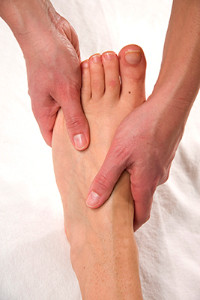 There are several benefits to the overall health of the feet when the toes are properly stretched. Toes may deform gradually over time as a result of several factors. These may include wearing shoes that are too snug for extended periods of time, improper use of the foot muscles while walking, or standing with the feet pointing outward, which puts pressure on the big toe. When the toes are stretched, the possibility of developing Athlete's foot may diminish as a result of adequate space between the toes. There are simple and effective toe stretches that can be performed daily for optimum results. These may include bending your toes downward to stretch the top of the foot, and taking each toe in your hands while pulling it away from the toe next to it. If you would like additional information about the benefits of stretching your toes, please consult with a podiatrist.
There are several benefits to the overall health of the feet when the toes are properly stretched. Toes may deform gradually over time as a result of several factors. These may include wearing shoes that are too snug for extended periods of time, improper use of the foot muscles while walking, or standing with the feet pointing outward, which puts pressure on the big toe. When the toes are stretched, the possibility of developing Athlete's foot may diminish as a result of adequate space between the toes. There are simple and effective toe stretches that can be performed daily for optimum results. These may include bending your toes downward to stretch the top of the foot, and taking each toe in your hands while pulling it away from the toe next to it. If you would like additional information about the benefits of stretching your toes, please consult with a podiatrist.
Why Stretching Is Important for Your Feet
Stretching the feet is a great way to prevent injuries. If you have any concerns with your feet consult with one of our podiatrists from Foot Health Center of Merrimack Valley. Our doctors will assess your condition and provide you with quality foot and ankle treatment.
Stretching the Feet
Stretching the muscles in the foot is an important part in any physical activity. Feet that are tight can lead to less flexibility and make you more prone to injury. One of the most common forms of foot pain, plantar fasciitis, can be stretched out to help ease the pain. Stretching can not only ease pain from plantar fasciitis but also prevent it as well. However, it is important to see a podiatrist first to determine if stretching is right for you. Podiatrists can also recommend other ways to stretch your feet. Once you know whether stretching is right for you, here are some excellent stretches you can do.
- Using a foam roller or any cylindrical object (a water bottle or soda can will do), roll the object under your foot back and forth. You should also exert pressure on the object. Be sure to do this to both feet for a minute. Do this exercise three times each.
- Similar to the previous exercise, take a ball, such as a tennis ball, and roll it under your foot while seated and exert pressure on it.
- Grab a resistance band or towel and take a seat. If you are using a towel, fold it length wise. Next put either one between the ball of your foot and heel and pull with both hands on each side towards you. Hold this for 15 seconds and then switch feet. Do this three times for each foot.
- Finally hold your big toe while crossing one leg over the other. Pull the toe towards you and hold for 15 seconds. Once again do this three times per foot.
It is best to go easy when first stretching your foot and work your way up. If your foot starts hurting, stop exercising to ice and rest the foot. It is advised that you then see a podiatrist for help.
If you have any questions, please feel free to contact one of our offices located in North Andover, and Tewksbury, MA . We offer the newest diagnostic and treatment technologies for all your foot care needs.















